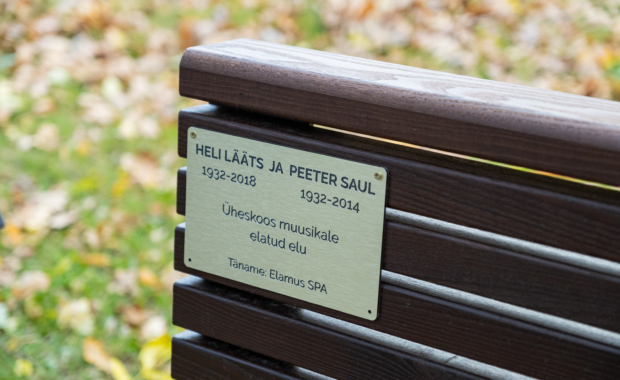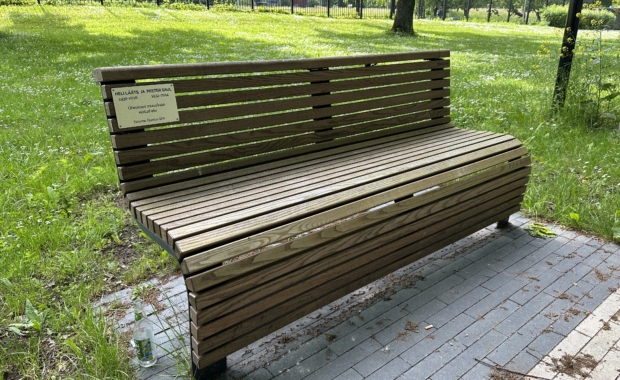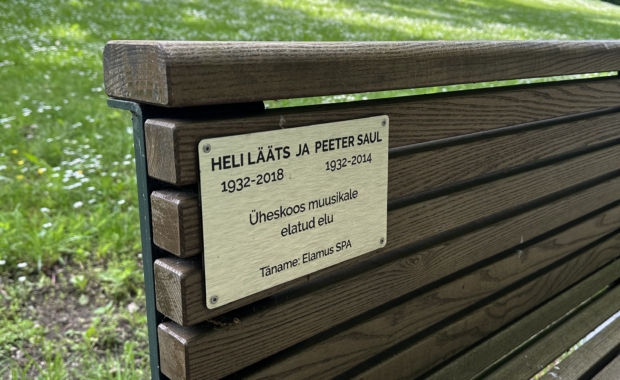Heli Lääts and Peeter Saul
(24.06.1932 – 16.02.2018) and (26.01.1932 – 2.07.2014)
Two beloved musicians—Heli Lääts and Peeter Saul—share a commemorative bench, just as they shared 56 years of life, creativity, and the stage together.
Heli Lääts, born in Kuressaare, Saaremaa, graduated in 1960 from the Tallinn State Conservatory with a specialization in classical singing, becoming the first Estonian singer to receive qualifications as a pop and chamber vocalist. Lääts was one of Estonia’s most renowned, experienced, and distinctive popular singers, who also performed as a chamber vocalist, participated in variety shows, and sang children’s songs. Her repertoire was extensive, and many composers wished for Heli Lääts to be the premiere performer of their songs.
Heli Lääts was a member of the Estonian Radio Female Ensemble from 1953 to 1956 and of a female trio from 1957 to 1961, and she was the soloist of Emil Laansoo’s ensemble from 1957 to 1974. From 1957 to 1987, she served as a soloist at the Estonian SSR State Philharmonic, and from 1966 to 1974, she was a pedagogue at the Estrada Studio. In addition to her singing career, Heli Lääts dedicated herself to advancing music education and mentoring young singers.
In the hearts of thousands of Estonians, Heli Lääts’ unforgettable songs hold a special place: “Ei me ette tea”, “Oma laulu ei leia ma üles”, “Tsirkus”, “Tänav, pink ja puu”, “Kaunid baleriinid”… and the list goes on. Her contribution to Estonian cultural life has been recognized with numerous honors, including the title of Honored Artist of the Estonian SSR (1970) and the Order of the White Star, V Class (2004).
Peeter Saul, born in Tallinn, began his musical journey at the Tallinn Music School, graduating in 1950 with a specialization in piano and in 1957 with a specialization in music theory. From 1950 to 1953, Saul also studied at the Faculty of Civil Engineering of Tallinn Polytechnic Institute, and from 1957 to 1961 at the Tallinn State Conservatory in Bruno Lukk’s class. He completed his studies in 1970 with a specialization in conducting wind orchestras at the Tallinn State Conservatory and furthered his education through distance learning at the Leningrad Conservatory from 1971 to 1973 under the guidance of Ilia Musin.
Peeter Saul became an exceptionally popular pianist and conductor, playing piano for over 30 years in Emil Laansoo’s ensemble and conducting major symphony orchestras not only in Estonia, but also in Finland and the former Soviet Union, and later in Russia. As a talented arranger, he arranged nearly 5,000 musical pieces, primarily for the Estonian Television and Radio Variety Orchestra, but also for symphony orchestras, and served as conductor for the music of several films. He collaborated closely with his wife, Heli Lääts, arranging countless songs for her and often accompanying her at concerts.
The Estonian Public Broadcasting archive holds a studio concert of Heli Lääts (1988), in which she is accompanied by the Tele-Radio Committee Concert Orchestra conducted by Peeter Saul.
The texts have been compiled using materials from Estonian Public Broadcasting (ERR) and the Estonian Music Information Centre (EMIC).


